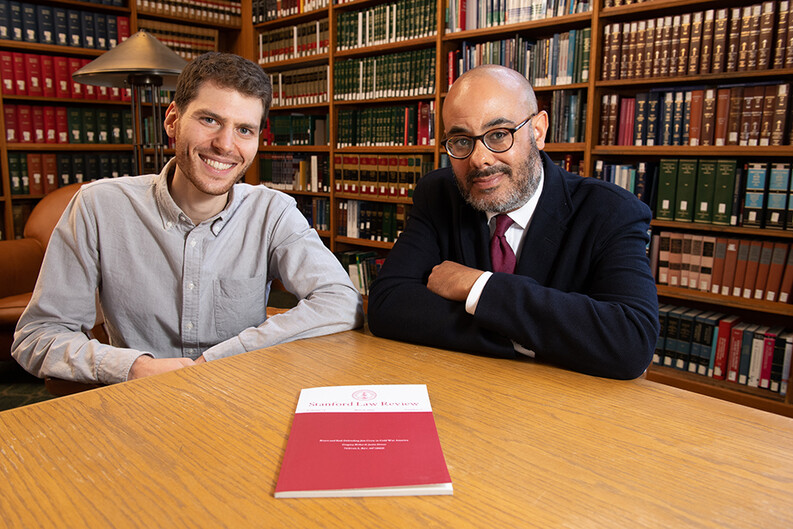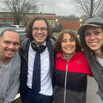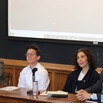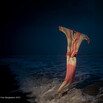Force Multiplier

Collaborations between faculty and students on academic papers enhance the process — and the scholarship
Justin Driver had some big news to share with his student Gregory Briker ’24. So, on March 1, 2021, he typed out the only message that could convey the heights of his excitement: “!!!!!”
With that joyful explosion of punctuation, Driver, the Robert R. Slaughter Professor of Law, told Briker that the article they had co-authored, “Brown and Red: Defending Jim Crow in Cold War America,” was in the final stages of consideration at the Stanford Law Review, where it ultimately appeared in March 2022.
For Driver and Briker, having their work published in one of the country’s top legal publications was the exclamation point on a monthslong research and writing partnership. They’d started talking in office hours — Briker, who is interested in school integration, had read Driver’s 2018 book, The Schoolhouse Gate: Public Education, the Supreme Court, and the Battle for the American Mind — and, Driver said, “we haven’t stopped since.”
Driver and Briker aren’t alone in finding success through student-faculty collaboration. Many Yale Law School faculty members have made a habit of publishing with students and recent alumni — among them Professor of Law Monica C. Bell ’09 and Allen H. Duffy Class of 1960 Professor of Law John Witt ’99, who published four papers with students in 2020 alone. Even the school’s leaders have happily shared their bylines: Dean and Sol & Lillian Goldman Professor of Law Heather K. Gerken regularly publishes with students, as did former Dean Guido Calabresi ’58.
That’s largely due to the students themselves. “The biggest reason I decided to come to Yale four years ago was the opportunity to work with the future law professors of the country,” said Driver. Witt agreed, describing his students as not just brilliant lawyers in training but also “scholars in the making.”
The school’s small size helps, too: In seminars and office hours, students and faculty have the time to connect and discover areas of shared interest. “The intimacy of the school contributes to having an intellectual knowledge of students [that makes it possible] to construct a collaboration from the ground up,” said Bell. Often, students graduate from eager classroom participants and office hours attendees to research assistants and then co-authors.
What results from such partnerships is a formative educational experience for students, as well as important works of legal scholarship. In fact, Gerken considers her 2009 paper with Jessica Bulman-Pozen ’07, “Uncooperative Federalism,” one of her most significant publications; it has been cited 631 times, according to Google Scholar.
“This kind of authorship opportunity has immense value for minority students at law school and particularly those interested in academia.”
—Alexander Nabavi-Noori ’21
For students with an interest in academia, publishing with a faculty member is both a significant career milestone and a valuable opportunity to learn the craft of scholarship. That was certainly the case for Briker, who is pursuing a Ph.D. in history alongside his J.D. “I knew that at some point down the road, trying to publish was going to be important,” he said, but he never imagined it would happen so quickly. At best, he thought he’d work as Driver’s research assistant, “helping out with some things he was working on, learning from him, and learning about the law in the process.”
But the duo quickly discovered a mutual interest in the relationship between anticommunism and opposition to school desegregation that felt robust enough to be a full article. The beginnings of the project coincided with the early days of COVID-19, so much of the discussion unfolded over phone, Zoom, and email. “This piece really was a pandemic baby,” Briker joked.
Each author brought different strengths to the project. For Driver, it was helpful that Briker was not only “uncommonly bright” but also “steeped in the arguments taking place in history departments.” Briker saw how their ideas built on those of other historians working in related areas, adding those perspectives to the work.
Similarly, Briker appreciated Driver’s insights about “how to write historically, but toward legal audiences,” he said. What’s more, Driver made time for “real, in-depth conversations about everything from big-picture arguments to seemingly small stylistic points.” When it came time to fine-tune the text of the paper, “he could have made changes on his own, but he wanted to bring me into the process, and use this as kind of an educational vehicle.”
Even for students without academic aspirations, working alongside a faculty member can offer valuable preparation for their future work. Stephanie Garlock ’20 said co-authoring a Duke Law Journal paper on the criminalization of poverty with Bell and classmate Alexander Nabavi-Noori ’21 was a happy accident of her time in law school—as well as a useful learning experience.
Bell is “a really brilliant writer and thinker, and also just very collaborative,” Garlock said, always willing to respond to new ideas as they arose and take the work in unexpected directions. The process of working together to hone ideas and decide how best to present them is not so different from her work as a law clerk from 2020 to 2022, she said: “Being a lawyer is often sort of like a group writing project.”
For Nabavi-Noori, the collaboration was one of the highlights of his law school experience. “This kind of authorship opportunity has immense value for minority students at law school and particularly those interested in academia,” he said. “I know that one of the reasons Monica seeks student co-authors is to aid in the diversification of the authorship pipeline.”
For faculty, publishing with students is both a teaching opportunity and a chance for meaningful two-way exchange. “These collaborations are helpful and have been valuable for the same reasons all collaborations are helpful and valuable,” said Bell. “Our students have a lot of knowledge and a lot of energy and ideas to add to the work.”
“Our students have a lot of knowledge and a lot of energy and ideas to add to the work.”
—Professor
Monica C. Bell ’09
In the case of her article with Garlock and Nabavi-Noori, for instance, Garlock was particularly attuned to real-world, on-the-ground effects, while Nabavi-Noori brought an interest in judicial practices. “Our article wound up focusing a lot on judges, and that focus actually didn’t come from my original thoughts about what the project would be,” said Bell. “It really emerged more because Stephanie and Alexander have particular expertise in those areas.”
Students can also bring fresh perspectives to ideas faculty have been studying for years. For a forthcoming paper with Morgan Savige ’22 on the foreseeability standard, Witt — who jokingly described himself as “an old fuddy-duddy now” — knew he didn’t want to write a paper about “an old set of problems,” he said. Instead, he leaned on Savige, as well as Selena Kitchens ’22, who helped with research for the paper, “to figure out what are the contemporary 21st-century problems to which this foreseeability analysis might apply with special power … and they came up with a bunch of really great contemporary applications.”
For instance, they discovered a variety of interesting new cases related to COVID-19 — passengers suing cruise lines for getting sick, insurance companies arguing COVID was an “act of God” — that got to the heart of the issue. “There was a question of, was COVID foreseeable? At what point of being with a group of people is it foreseeable that you might get an infectious disease?” Savige explains.
Savige, who is now a tax attorney, says collaborating on the paper with Witt was valuable preparation for her current work. “We sit around thinking through what are, essentially, logic problems — thinking through different chains of argument and needing to go find research [to support them],” she says. “And that was a lot of what we did when writing the paper.”
What’s more, the process offered a chance to learn from a faculty member one-on-one. “I was very lucky to be able to work with Professor Witt so closely and see how the writing process works with someone who’s such an amazing writer and thinker,” she says.
To Witt, the benefits of collaboration are simple. “I have ideas and I have a limited amount of time. Yale students are a force multiplier. And more importantly,” he said, “the ideas get better in the execution through working with students.”


